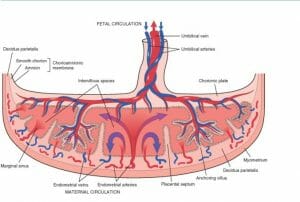Fun Facts About the Placenta

All nutrients acquired by a developing baby in the womb are transferred by the placenta. The human placenta is made by the growing embryo and fetus. Its tissues invade the blood vessels of the mother’s uterus and attach using anchoring pillars (septum) made by the placenta (see image). The final placenta is very porous, almost like a sponge.
Maternal blood runs through the placenta to provide oxygen and nutrients to the baby. The placenta makes little tree-like branches that wave in the mother’s blood as it flows by. The “leaves” of the tree contain tiny blood vessels from the fetus which pick up large amounts of water, oxygen, sugars, amino acids, healthy fats and other nutrients from the mother’s blood, which the fetus uses to build itself into a baby ready for outdoor life.
The shape of the placenta has meaning:
- Round placentas are the most common.
- Placentas that are oval or odd-shaped are often associated with later-life disease risk in the offspring. That does not mean that every baby born with an oval or misshaped placenta will get a disease in later life - but it does mean that such a baby has a higher risk than those born with a round placenta. Oval placentas are associated with a variety of disease conditions in adults, including heart disease in men.
- A placenta may become misshapen by stressful conditions in the womb, including abnormal fetal blood vessels, poor maternal nutrition or conditions like preeclampsia. Researchers have studied the effects of famine on the placenta, by examining detailed birth records kept by the Dutch during the Hunger Winter of 1944-45. Read more about the effects of famine on the placenta.
- The shape of the placenta is influenced by the oxygen environment in the womb while the placenta is being formed. The oxygen levels in the lining of the uterus are normally low. This stimulates the placenta to grow. While the placenta is establishing itself, it blocks off the blood coming from the mother's spiral arteries for a few weeks to keep the oxygen levels low - until it has its structure properly formed. If the oxygen levels get too high, placental growth is impeded. This may be one way the placenta can become odd shaped. If one or more arteries do not plug, the oxygen from the mother may suppress the growth of the placenta along the edges or elsewhere.
An average placenta weighs about a pound at birth but there is enormous variation in weight when a baby is born full term. In the early stages of pregnancy, the placenta weighs more than the baby. Girls have larger placentas than boys on average and are safer if there is a food shortage. This is because boys grow as fast as possible over the course of pregnancy with as little placental tissue as possible, making them more vulnerable if their nutrition is compromised. Girls are more influenced by maternal metabolism and make a larger investment in placental growth.
The size of the placenta compared to the body weight of the baby is important in predicting chronic conditions. A tiny placenta attached to a large baby is one example. An extra-large placenta attached to a small baby is also associated with risk. However, risk does not foretell a certain outcome of the offspring but suggests elevated risks in later life. Most of the risk dissipates over the life course in people who have healthy diets and lifestyles.
The placenta makes many hormones. Some keep the pregnancy running. Others stimulate changes in the mother’s body, including breast development and changes in heart, kidney and blood vessels – all designed to provide a body that is optimal for providing nutrients for the baby.
In many societies, the placenta has a spiritual meaning. The placenta is the most important organ in a person’s life because a person would not exist without it. Different cultures have different rituals for honoring the placenta. Some ceremoniously plant it near a tree. Others consume it. A recent fad is to have it dried and later consumed in capsules. People have been harmed by this practice. There is no scientific evidence that the nutritional value in the placenta makes it worth consuming even though many animals consume the placenta after birth.
_______________________________________________________________________________________________________________________________________________________________________
Image courtesy of: Biologydictionary.net Editors. (2017, July 25). Placenta. Retrieved from https://biologydictionary.net/placenta/ on Oct. 18, 2022.